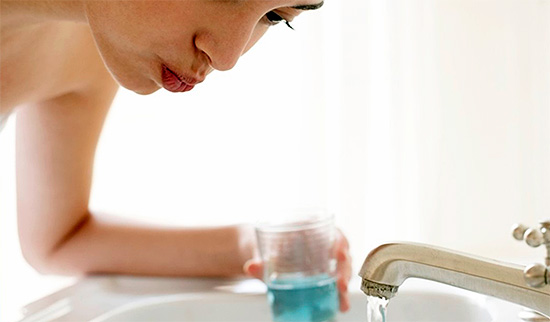
Next you will find out:
- In which cases a mouth rinse after tooth extraction can do more harm than good;
- The better to rinse your mouth so that your gums heal faster and how to do it properly;
- What means should not be used categorically so as not to aggravate the situation;
- Properties of some pharmaceutical and folk remedies suitable for rinsing the mouth after tooth extraction;
As well as a number of other interesting nuances that are important from a practical point of view.
After the extraction (extraction) of the tooth, the person who has become tormented often faces the question of how best to rinse your mouth so that the wounded gum heals faster. In this case, initially the situation is usually the following: after the roots are removed from the hole, the dentist places a sterile gauze pad on the wound and asks to pinch it tightly, clenching its jaws, and hold it for 15-20 minutes.Sometimes, in front of the tamponade, the doctor may stitch up to minimize the risk of suppuration of the wound (alveolitis).
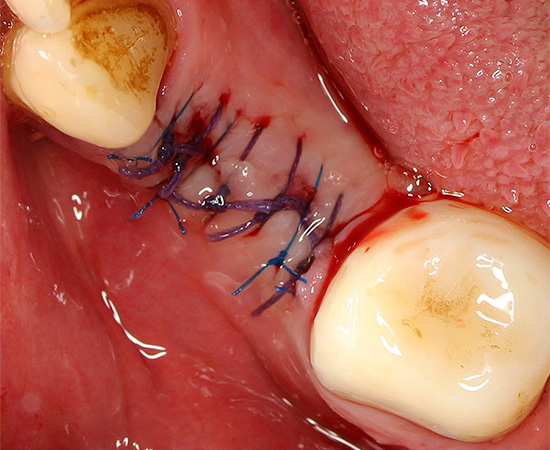
This is approximately in this state that a person comes home: the mouth is full of blood, the anesthesia is already moving away, the gum is sore, the cheek begins to swell, or it is already swollen. The natural desire in such a situation is to rinse out your mouth as quickly as possible with something disinfecting, so that at home and in a relaxed atmosphere you can disinfect the wound and, if possible, reduce pain.
However, before deciding how to rinse your mouth after a tooth is removed, let's first focus on two main problems that are still the subject of debate and controversy among dental surgeons:
- Does the patient really need to rinse his mouth after a tooth is removed?
- And the second question - is there an alternative to rinsing ways to speed the healing of the gums?
Do they really need these gargles if they can even harm a person?
Many researchers of this issue came to the conclusion that a number of rinse techniques, appointed by dentists and practiced in our country, are not only not useful, but in some cases very harmful to human health. The main negative point here is the destruction of a blood clot formed after the removal of a tooth, which is a natural factor in the biological protection of a wound against the attachment of a secondary infection.
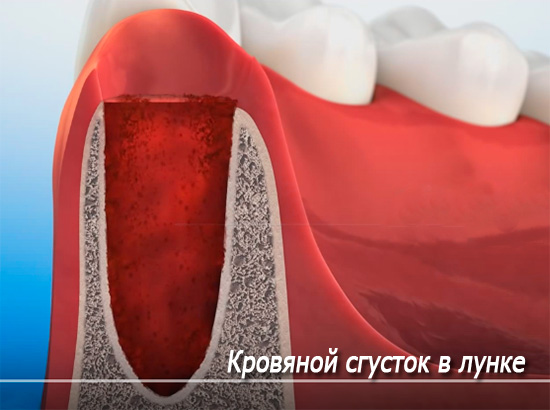
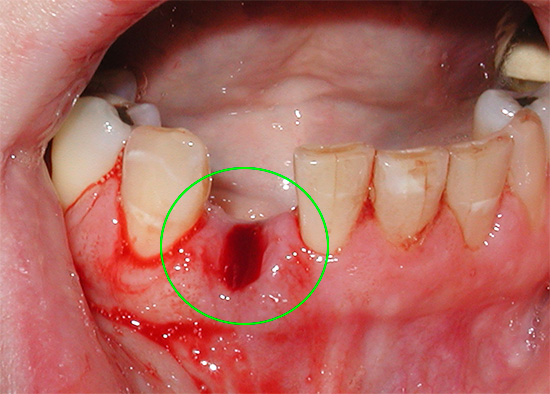
Therefore, today some leading maxillofacial surgeons of the country practicing tooth extraction and complex maxillofacial operations initially warn against rinsing the mouth immediately after a tooth is removed, believing that after a qualitatively performed surgical procedure in all respects, such a procedure does not accelerate gum healing, but, on the contrary, it will create additional risks of suppuration of the wound. But, of course, not so simple, and speaking of the rinses, it is necessary to take into account a number of other nuances.
In this case, to whom, why and in what situations are mouth rinsing after tooth extraction? Is it possible to do without them, and what alternative methods for the favorable healing of the gums does modern dentistry offer us - let's understand ...
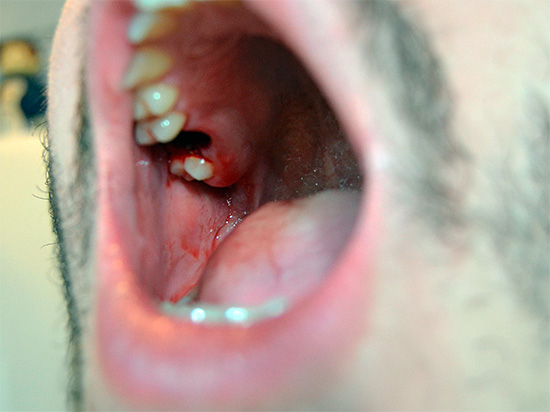
Expert comment
“I am a practicing maxillofacial surgeon with 15 years of experience. At that time, when my formation as a specialist was just beginning, there were many different approaches to the recommendations for patients after tooth extraction.I actively listened to the advice of familiar experts and appointed rinsing with soda and decoction of herbs (chamomile, sage), believing that this would improve the quality of healing of the hole after tooth extraction.
And only much later (years after 5 years), it became clear to me that the lion’s share of all these methods was not developed entirely for “our” people. Due to too hard rinsing almost from the first hours after tooth extraction, many of my patients simply washed the blood clot from the hole, and I had to treat alveolitis almost every week. The empty hole quickly began to get clogged up with leftover food and other filth, causing a strong suppuration.
So now, in my practice, I prefer to “ennoble” the hole after the extraction of the tooth in such a way so as not to prescribe any rinses, ointments, baths, lotions and other heresies. At the same time, I have practically no alveolitis, which is not that for a month, but sometimes for a year! In general, my position on mouth rinses is fully covered and, I hope, my colleagues and their patients will come in handy. ”
Dentist-surgeon, Perevozchikov V. S., Moscow
Why rinsing is still needed and what advantages they give
Many dentists are of the opinion that it is still useful to rinse your mouth after a tooth is removed, since it allows you to:
- To clean the wound from the remnants of food after eating;
- Reduce the number of bacteria in the wound and the oral cavity as a whole;
- Create prerequisites for favorable healing of the gums.
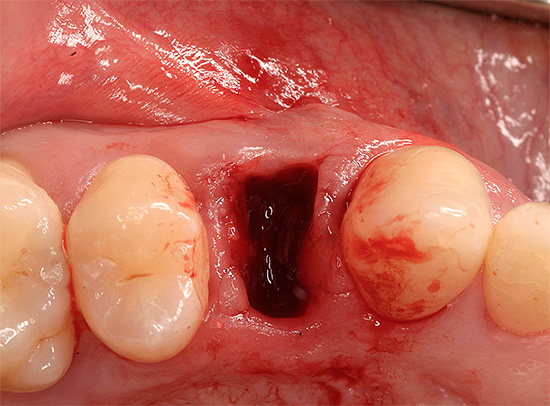
For rinsing the oral cavity after tooth extraction, the dentist-surgeon may recommend using both folk remedies (decoctions of chamomile, oak bark, sage, soda or salt solutions, etc.) and special pharmaceutical preparations (for example, chlorhexidine, furatsilin, miramistin and others).
So a very important (and, perhaps, the main) advantage of rinsing is realized - pathogenic and conditionally pathogenic microorganisms are destroyed in the wound and mouth cavity. Most often, it is the conditionally pathogenic bacteria that “wait” for the situation when, against the background of a decrease in general or local immunity, they can harm a person, causing, for example, after tooth extraction, an inflammation of the hole and its suppuration.
On a note
In addition to the influence of microbes that are accidentally introduced into a fresh hole during and after surgery, there are also a number of aggravating factors: almost every second case of tooth extraction is carried out without prior sanitization of the oral cavity.In other words, around the fresh wounds are carious or even completely destroyed teeth (see the example in the photo below), plaque and a stone may be present on the teeth adjacent to the hole. All this creates additional risks of inflammation of the hole, creating prerequisites for the development of alveolitis.

Thus, by rinsing the mouth, it is possible to achieve a significant reduction in microbial activity in and around the wound, as well as to improve the state of oral hygiene as a whole, even against the background of the unfavorable cariogenic situation and low purity of the teeth. Advocates of rinsing emphasize the possibility of creating a favorable environment for quick and painless healing of the gums - and this is quite a weighty argument.
But opponents of any rinses, on the contrary, emphasize a high percentage of the risk of “rinsing out” a protective blood clot from the hole, which almost always leads to the alveolitis (inflammation of the tooth hole) and significantly reduces the healing rate of the gums.
Is it possible to somehow find a middle ground between these two opposing approaches? Fortunately, yes, it can be done, and then we will not only considerhow to implement it correctly in practice, but also try to figure out the better mouth rinse after tooth extraction in order to get the maximum positive effect and minimize the risks of complications and leaching of the blood clot from the wound.
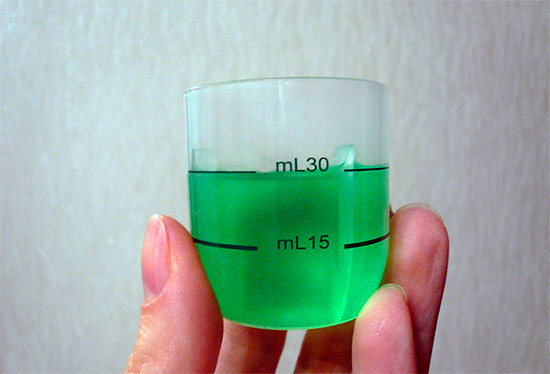
Dentist recall
“Doctors of our hospital constantly advise to rinse out mouth with soda and salt after tooth extraction. I can not understand where they were taught this, but after their appointments patients often come with alveolitis. Is it really not clear that soda and salt during normal rinsing literally “tear off” the blood clot and create a favorable environment in the empty well for the reproduction of bacteria. Soda-salt solutions are best suited as mouth baths: I held it in my mouth - I spit it out carefully and that was all. No need to rinse! Why spoil your life for yourself - I do not understand ... "
Irina, Omsk
When is it better to start rinsing your mouth after tooth extraction, and how to do it correctly
Since the debate about the advisability of rinsing the mouth after the removal of teeth still does not subside, a third opinion arose, so to speak, against the background of these confrontations. Having a little understood this new position of doctors, even an ordinary person without training will understand the answers to the following questions:
- When exactly can you start rinsing your mouth after tooth extraction (how many hours) and how many days should it be done;
- The better to rinse your mouth to achieve a positive effect and at the same time avoid the effects of negative ones.
Let's first look at the first item in detail.
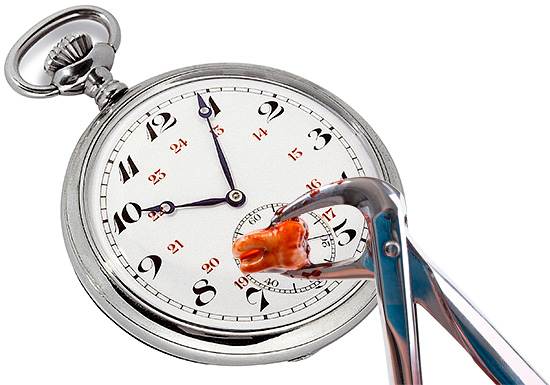
As soon as the dentist-surgeon completes his work and places a sterile gauze pad on the bleeding wound, a blood clot begins to form in the fresh tooth well. It is important to adhere to the following recommendations:
- Do not eat or smoke for 2–3 hours after tooth extraction;
- during the first day it is especially important not to pick a hole and try not to touch it with the tongue;
- to save a blood clot in the hole, it is impossible to steam in the bath, overheat, and engage in hard physical labor for the first few days after the extraction of the tooth;
- It is not recommended to sleep with the side of the face down where the tooth was removed.
Is it possible to rinse your mouth on the very first day after tooth extraction? According to studies, any rinsing during this period of blood clot formation is a direct risk of its breaking and leaching. In this case, the so-called dry-hole effect often occurs, and subsequently - its suppuration.
However, no one forbids carrying out antiseptic mouth baths according to the principle: “I put it in my mouth and spit it out”. Oral baths are good because they have practically no restrictions on the frequency of the procedure (within reasonable limits), so they can be carried out not only after eating, but also between them - at least 5-6 times a day, depending on for rinsing means.

Feedback:
“... My girls, you can't rinse your mouth with anything at all, otherwise the clot will fly off the gums, and you will not stick it back! About a year ago, I had a difficult wisdom tooth extraction, when even sutures were applied. The doctor strictly forbade me to rinse with anything, but I recommended oral baths with Romazulan. That is, do not gurgle in the mouth, but just hold it for 10 seconds and spit it out.
My friend told me that she managed to start rinsing after 4 hours after tooth extraction. For this, she prepared herself almost a hot solution of soda and salt.As she told me, this is for the microbes to dissolve faster. But in the end I suffered the first day with bleeding from the gums, and then several more days with severe pain, until I went to the doctor. And she got her brains right for self-medication. Therefore, girls, whose hands itch to soda and salt, immediately recall the sad experience of my girlfriend. ”
Evgenia, Saratov
Now let's see what you can do mouth baths after tooth extraction (or very gently rinse your mouth - a few days after the procedure) and what kind of "pitfalls" when choosing one or another tool should be aware in advance.
Drugs used for rinsing the mouth after tooth extraction
In order to understand the better mouth rinse after tooth extraction (hereinafter, this formulation should also be understood as oral baths), we will try to evaluate the properties of the most commonly prescribed means by dental surgeons. The most popular of them are:
- Chlorhexidine;
- Furacilin;
- Potassium permanganate;
- Miramistin;
- Herbal decoctions (doctors can also prescribe them, despite the fact that they are, in general, traditional medicine).
How to rinse with chlorhexidine and preparations based on it
Chlorhexidine is an effective antiseptic with high antimicrobial activity against gram-positive and gram-negative bacteria, protozoa, as well as some viruses. 0.05-0.1% aqueous solutions of chlorhexidine (usually in the form of a digluconate) can be used as rinses.
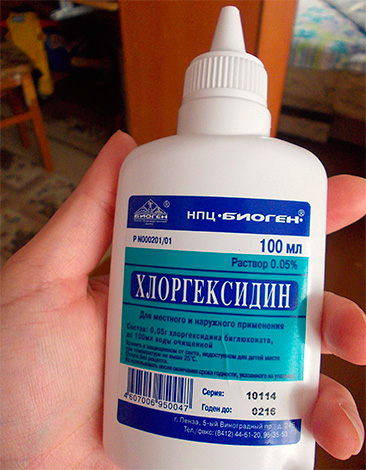
As usual, it is recommended to rinse your mouth with chlorhexidine after tooth extraction:
- First, it is recommended to rinse the oral cavity with ordinary warm boiled water (however, now you know that this insidious recommendation without additional explanations can easily lead to leaching of the blood clot; therefore - do not rinse actively! Got in your mouth - and spit gently);
- Then you should take 10-15 ml of chlorhexidine solution into your mouth and make movements of the solution in the oral cavity for 20-30 seconds, repeating the procedure 1-2 times (again, it is better to do without active movements of the solution, that is, without “gurgling”; just do the bath). As a rule, 2-3 rinses per day are sufficient.

It is important to know!
If a burning sensation appeared in the mouth during rinsing, it means that the concentration of the solution is too high.You must immediately take in the mouth of warm clean water and remove the remnants of the drug as soon as possible. The recommended safe concentration of solutions for mouth baths and rinses is no more than 0.5%, and generally better than 0.1% (there are also higher concentrations available, so be careful). With self-preparation of the solution, it is important to strictly follow the breeding scheme.
Chlorhexidine preparations may have other names. For example, Korsodil is the same aqueous solution of chlorhexidine, but it costs much more because of its imported origin. The difference in price is significant, but the result is the same.
We should not forget about the contraindications: for children (especially young children) chlorhexidine and its analogues are not recommended for use, or are used with extreme caution. Yes, and why rinse your mouth with chlorhexidine after removing a tooth from a small child, because a crumb can accidentally swallow the solution. In addition, chlorhexidine with extreme caution should be used for pregnant and lactating women, as well as in case of individual intolerance to the substance.
Can furatsilin be used after tooth extraction to heal faster?
In Soviet times, rinsing with furatsilin was very popular in dentistry and otolaryngology (and not without reason). A better way to fight the infection than rinsing the mouth with furatsilinom after removing the tooth with pus then simply could not come up.
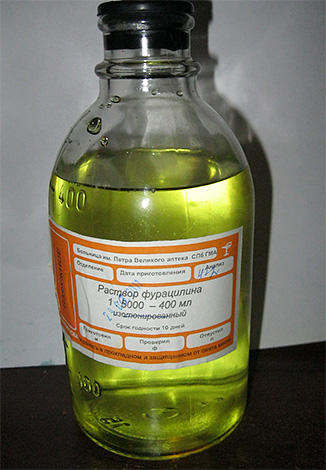
When doctors realized that the appointment of intensive rinsing (especially on the first day after tooth extraction) adversely affects the blood clot and its preservation, a more progressive option was proposed - mouth baths with furatsilin solution. The principle is:
- Take the finished aqueous solution (non-alcoholic!) In bottles (0.02%), or dilute 10 tablets of furatsilin (0.01 grams each), or 5 tablets (0.02 grams each) per liter of water;
- Keep in mouth for 1-2 minutes 3-4 times a day (do not rinse).
It is interesting
Furacilin is a relatively weak antiseptic (especially, so to speak, in modern purulent surgery), and the resistance of many microorganisms to its action has been proven. Furacilin often dries the mucous, has an extremely unpleasant bitter taste, memorable for life.
Unfortunately, it is not always possible to find ready-made diluted furatsilin bottles, but tablets are available at any pharmacy. Diluting 10 tablets per liter is impractical because usually a small amount of solution is required. This is where the fun begins, called by the people "by eye". And the result of such experiments are often irritation of the oral mucosa.
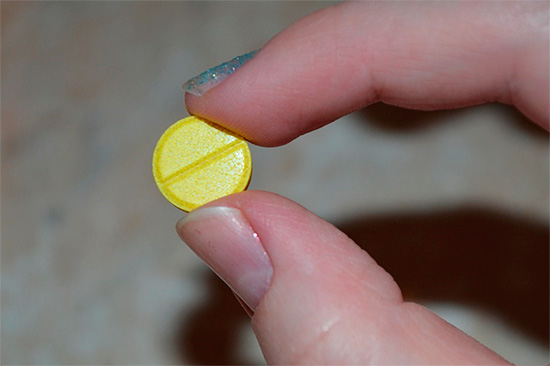
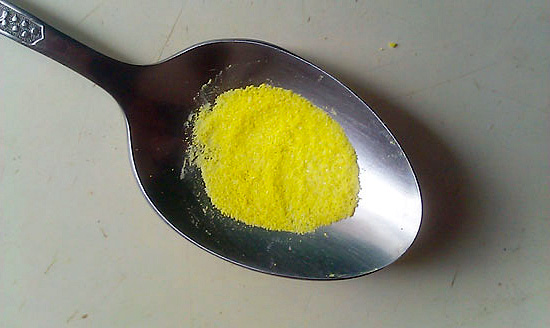
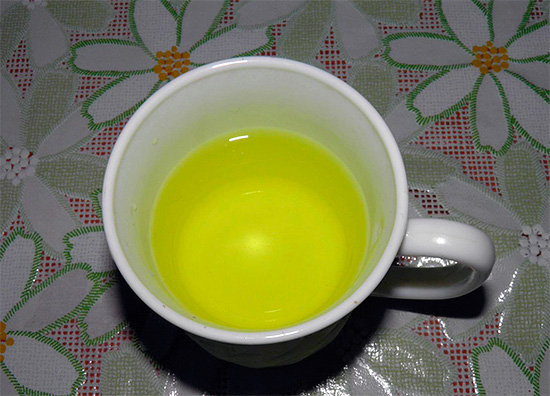
About mouthwash Miramistin
Miramistin, despite some similarity on the principle of action to chlorhexidine preparations, has a wider spectrum of action against bacterial, fungal and viral infections. Besides the fact that he actively fights against various pathogenic bacteria, fungi and viruses that can be in the mouth and interfere with the normal healing of the hole, it has been proven to be safe for humans even with repeated use.
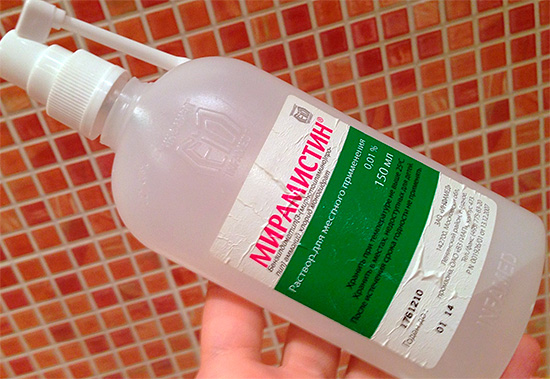
It is interesting
The development of Miramistin began to be carried out back in the 70s of the last century for astronautics. The scientists were tasked to find such an antiseptic that would be completely safe for humans, but very active against bacteria, fungi and viruses. It was planned to use it to disinfect the skin of astronauts and a number of instruments at the station. However, after the collapse of the USSR, research funding ceased, and only a group of enthusiastic scientists continued the search for such a drug.Only in 1991, Miramistin appeared, which, unlike its relative, chlorhexidine, had a wider spectrum of action and high antimicrobial activity, and was also safe for children, pregnant and lactating mothers.
So, imagine: you pulled out a tooth, and you are going to rinse your mouth with Miramistin. The concentration of its solutions, which you will find on sale, is always the same - 0.01%, and this is quite enough. For the needs of dentistry, bottles with spray nozzles are convenient, although, for example, in ENT practice, Miramistin solutions are used in bottles without such nozzles (for gargling the throat and tonsils).
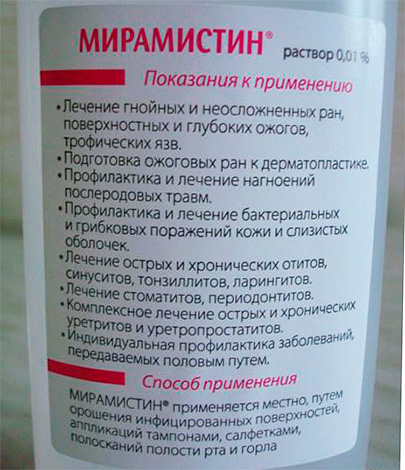
When buying at a pharmacy, it is helpful to warn the pharmacist for what purpose the product is being purchased, otherwise confusion may come out: the applicator for the urethra must be adapted to the oral cavity, since Miramistin with a urological attachment is also commercially available.
To disinfect a wound, it is enough to spray Miramistin's solution 1-2 times in the direction of the hole of the extracted tooth, keeping the nebulizer no closer than 5 cm from the hole - so as not to damage the blood clot with a jet. Then it is not necessary to wash away the sprayed antiseptic with water, that is, it is sprayed and forgotten.The procedure can be repeated 2-3 times a day for 5-6 days.
Rinsing the mouth with potassium permanganate solution
To prepare the "correct" 0.1% solution of potassium permanganate, you will need 1 gram of potassium permanganate powder and 1 liter of warm water. The solution should be slightly pink in color.
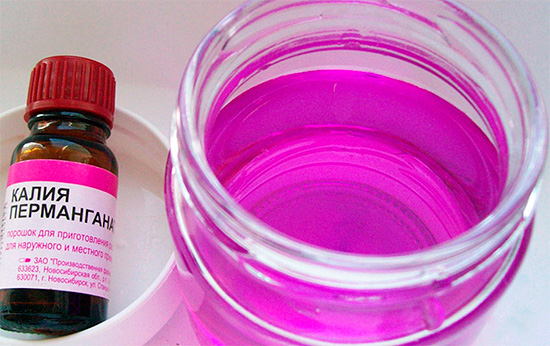
In the practice of dentists of the Soviet times, there were a lot of cases of burns of the mucous due to improper dilution of the drug at home, which is why for some other reasons it is better to rinse the gums after tooth extraction with something other than manganese solution. In addition, keep in mind that if individual crystals of permanganate have not yet dissolved, then rinsing the mouth with this solution can also cause a burn, even if the ratio of powder and water was initially taken correctly.
It is interesting
In order to dilute potassium permanganate, you must first purchase it in a prescription pharmacy according to a strict medical prescription. In 2007, by decree of the Government of the Russian Federation, potassium permanganate was excluded from free sale.
Can I rinse my mouth with vodka or alcohol?
It may seem that for the purpose of disinfection, it is quite acceptable to rinse the wound after the tooth is removed with alcohol or vodka.After all, ethyl alcohol is an excellent antiseptic.
However, dentists strongly oppose the use of alcohol solutions for rinsing the mouth.
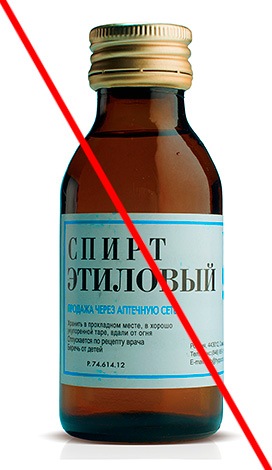
The reasons are as follows:
- Alcohol in general is a common cause of recurrent bleeding from the hole due to the separation of the resulting crust of a blood clot and the expansion of blood vessels;
- Alcohol irritates the oral mucosa, so the process gum healing after tooth extraction slows down;
- Vodka and alcohol can cause severe pain when it hits an open wound.
So no rinsing with alcohol and vodka, including it will be useful to refrain from taking intoxicating beverages inside for at least a few days.
Is it possible to smear the gums after the removal of the tooth with "green paint" or iodine?
Generally speaking, if you choose the lesser of two evils, then it would be safer to process the gum after you have a tooth pulled out with a 1% alcoholic solution of brilliant green ("green paint"), unlike the 5% alcohol iodine solution. Treatment of oral mucosa with such concentrations of iodine often causes severe burns, leading to erosions and ulcers.
But at least the "green" and less likely to harm the oral mucosa than the pharmacist solution of iodine, but from the point of view of logic and common sense to smear the gums after the removal of the tooth with "green paint" either on the first day or the next days is not worth it. First, it hurts (remember the effects of alcohol on wounds). Secondly, it is unsafe for normal healing of the gums due to its drying with such active antiseptics. Thirdly, when trying to smear "Zelenka" on the wound, it is easy to damage the blood clot.
In general, neither Zelenka nor iodine is highly recommended for treating the hole after the tooth extraction procedure.
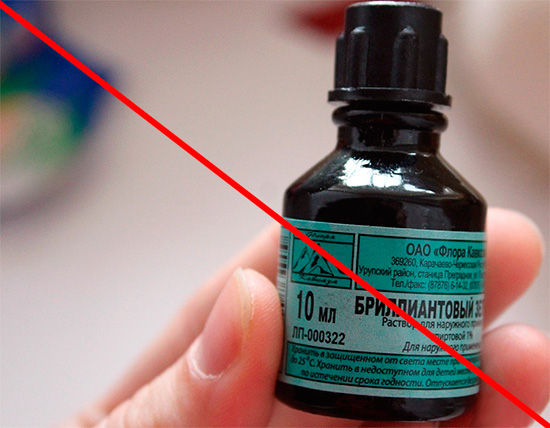
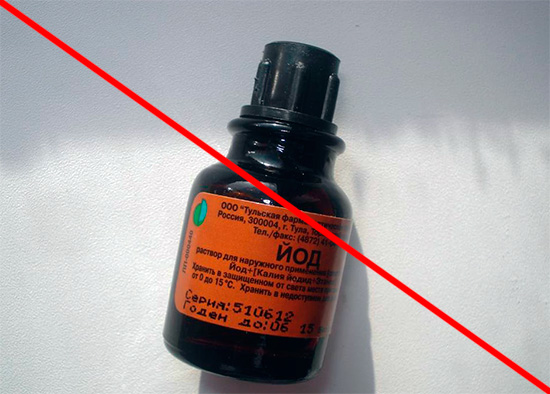
Feedback
“My friend is constantly smearing something with green paint in her mouth. Slightly what sore in the mouth - immediately brilliant green, and recently the tooth was removed and let's cauterise yourself there before stupor. No, well, I understand everything, bacteria and all that: sort of anointed and killed them, but why in such a barbaric way? It is full of all kinds of pharmaceuticals that do not burn the mouth, but the bacteria are also the only way to kill. ”
Alexandra, Moscow
The harm and benefits of hydrogen peroxide as a means of rinsing the mouth after tooth extraction
Pharmacy 3% hydrogen peroxide is a very powerful antiseptic that breaks down into oxygen and water during its work.Incidentally, dental surgeons also use the property of hydrogen peroxide to stop capillary bleeding after tooth extraction: In this case, 3% hydrogen peroxide is contacted on a gauze pad directly with the wound surface.
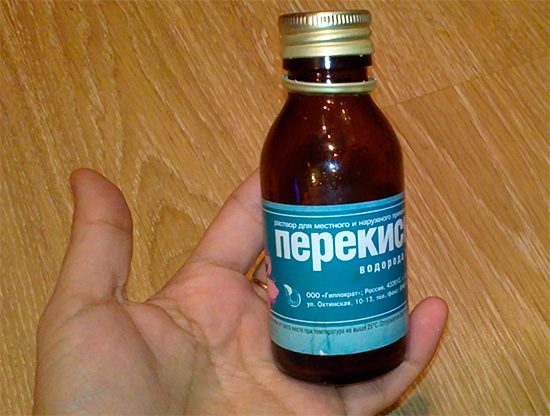
However, with all these positive properties, rinsing the mouth with hydrogen peroxide after tooth extraction can do more harm than good, so in home conditions you should not practice this method of disinfecting the hole. The main problem is that when the solution comes in contact with mucous membranes (especially with the wound surface), active foaming occurs with the release of oxygen bubbles. In some cases, this can lead to mechanical damage to the blood clot by expanding gas bubbles.

In addition, the 3% concentration of hydrogen peroxide is ideal only for local processing, but with mouth baths and gargles, irritation of the oral mucosa may occur.
Drugs based on herbal remedies for quick healing of gums
Among the pharmaceutical herbal anti-inflammatory drugs are very popular following:
- Chlorophyllipt;
- Salvin;
- Stomatofit.
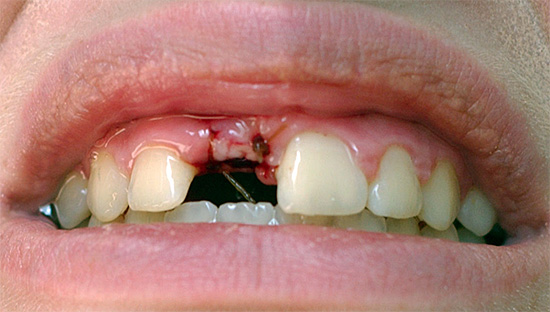
However, if someone recommends that you use these rinses after tooth extraction, it is useful to first take into account some of the nuances.
Chlorophyllipt is a drug derived from eucalyptus leaves. It has a moderately pronounced antibacterial activity and to some extent (on the whole slightly) stimulates wound healing. For wound disinfection, it is used as an alcohol tincture - we have already spoken about the negative effect of alcohol-containing solutions above.
Salvin is also an alcohol-containing drug, containing essential oils and tannins. It has anti-inflammatory and antimicrobial effects. Before use, the 1% alcohol solution is diluted by diluting with water to low concentrations (approximately 5-10 times), and used for applications, irrigation and lubrication. As you understand, in this form, the alcohol concentration is already significantly reduced. At best, Salvin can be applied topically to irrigate the hole after tooth extraction (mouth baths), but if pain and irritation appear, you should immediately refuse such treatment.
Stomatofit - phytopreparation based on herbal extract,having anti-inflammatory action. For dilution with water, there are special dosimeters and measuring tanks (diluted to 15% concentration). It does not irritate the oral mucosa, so in the first days after tooth extraction, it is quite suitable for oral baths.
Special mouth rinses
Many oral rinses for home use in addition to antibacterial activity also have a well-pronounced anti-inflammatory effect. For example, this includes a group of household oral hygiene products aimed at reducing the inflammatory reaction in the damaged gums - based on azulene, chlorophyll, pine extract, St. John's wort, sage, oak bark, etc.
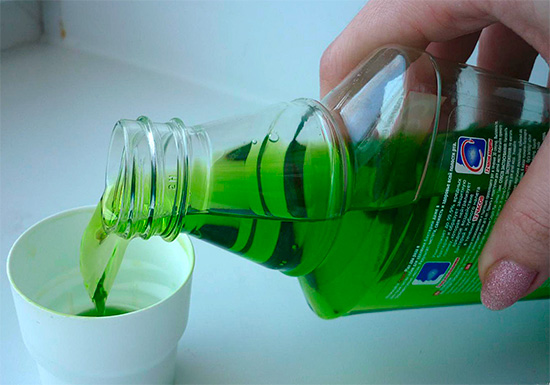
Careful use of such rinses as a means for oral baths is quite acceptable.
Feedback
“Basically, I didn’t use rinses until one day I was pulled out a wisdom tooth. It was a test that the enemy does not want. Yes, not only did they tear out a tooth for more than an hour, so on the third day pain in the gums started, and the smell of such a mouth went out, which was a shame to go to work.Right next to the washbasin there was a Forest Gum Conditioner, which my wife had not used for more than a year. A couple of times in the morning I rinsed them, relieved, the pain subsided slightly, it became easier to communicate with people. In the evening, I still held the balm in my mouth for a while, and in the morning, my gum barely ached ... ”.
Valery, St. Petersburg
Folk remedies for rinsing: advantages and disadvantages
Among the methods and means for household rinsing of the people which have fixed in the people two positions are in the lead:
- Soda-salt solutions;
- Decoctions of herbs.
The first category is currently the most, perhaps, controversial. Many dentists categorically do not accept any soda and salt (as well as combinations) rinsing either on the first or the next days after the tooth extraction., as it is associated with the irritating effect of the solution on the wound and the destructive action of the components of the solution on the blood clot.
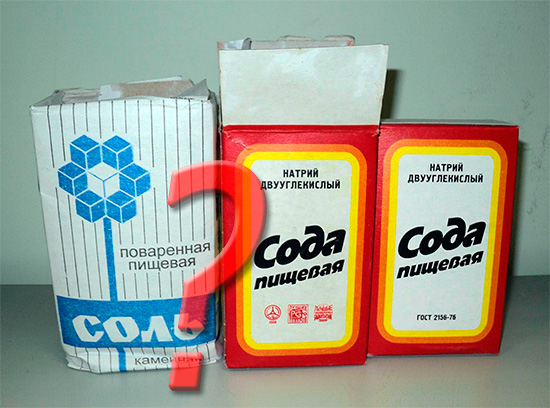
On a note
The so-called “old guard” of dentists still does not recognize other solutions than simply assigning the patient to rinsing the mouth with soda or saline (especially after removing a tooth with pus).Often there is a combination of soda and salt to achieve the greatest effect. The task of such rinsing is to “pull out” the pus from a wound with a hypertonic solution, although many dentists oppose this approach, considering it unscientific and too risky for the integrity of the blood clot.
In general, we can say this: with the existence of large risks of harming the blood clot, even with all the antiseptic and hygienic advantages of soda, in modern civilized society it is better to prefer another option for the care of the extracted tooth.
Now a few words about decoctions of herbs. Most dentists who are supporters of the most gentle rinses, choose exactly decoctions of herbs for rinsing the mouth after tooth extraction: the oral bath procedure is considered optimal for the first few days after the procedure. For this you can use, for example, decoctions of chamomile or sage.

Recall that mouth baths allow antiseptic irrigation of the healing wound without harm to the clot, since the option of "gurgling" in the mouth is excluded. In practice, the principle of "put a solution into the mouth and spit it out" is very effective when used repeatedly during the day.
Small summary
So why is it better to rinse your mouth after a tooth is removed so that gum healing will go quickly and without problems?
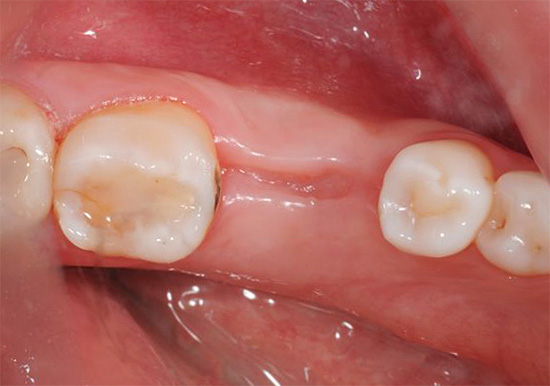
Well, the main options are:
- Do not rinse;
- Rinse with what the doctor recommended;
- Or restrict mouth baths gently acting antiseptics (were listed above).
Very many, including highly professional, experts hold the opinion that purposefully rinsing the mouth after the tooth extraction procedure is not worth anything at all, but at the same time focuses on the quality of the removal performed. In other words, the more professionally performed tooth extraction with minimal loss of tissues surrounding the well, the faster the wound will heal. In this case, regular rinsing by any means will only impede the normal healing of the hole.
It is also not recommended the imposition of any ointments or gels on the healing wound. All that was formed in a perfectly formed hole after tooth extraction is a blood clot that, when it is recommended to protect it from damage, does not need rinsing, being the best natural barrier to protect against the penetration of microbes and their toxins deep into the hole.
If the doctor still appointed you to rinse, then in a particular clinical case, most often it is quite reasonable. The most important thing here is not to self-medicate, and at the first signs of alveolitis (inflammation of the hole), you should contact your doctor. If you are confident in your dentist, then listen to him, and wound healing will take place without complications.
If you are in doubt about the competence of a doctor, you can get advice immediately from 1-2 specialists and draw conclusions. Fortunately, in most cases such advice is provided today absolutely free.
Interesting video: what is important to know about the healing of the hole after tooth extraction
About the appearance of pain some time after tooth extraction (alveolitis)

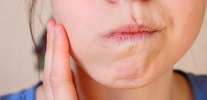

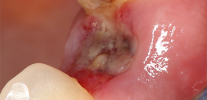
The article is excellent, but I realized that it was better not to rinse 🙂
Yes, it is better not to rinse, but if you want to play it safe, you can smear damages on the gums with periodontal disease. But the gel will help prevent inflammation and help the gums heal faster. I have already used this method 2 times (pulled out 2 wisdom teeth 🙁), it always helped perfectly. And you can start rinsing later, when the wounds start to tighten.
Sage helps well.
It is said, you can not lay the ointment. What kind of people are these ...
Sage - yes! It is necessary to hold in the mouth, after 6 hours, and rinse after each meal 4-6 days. As recommended by my dentist.
After the removal of the tooth, the gum swelled. How to rinse?
Hello! Without the appointment of a dentist is better not to rinse. It is advisable to find out why the gums are swollen (swelling due to injury or a beginning complication?). The scheme is as follows: determining the cause of the problem at the doctor - then adjusting the treatment - then the prescription. If it is done the other way around, then you can bring to serious problems and, in general, harm (vylososhte protective blood clot, there will be a dry hole, alveolitis, etc.). Heal properly. Health to you!
And the doctor left a tampon in the hole after the extraction of the tooth. Desna got sick. Asked her husband - he pulled the tampon with tweezers. First, feel better, then the pain intensified. I went to the doctor again, and she told me: why did they pull out? I say: this is a foreign object, it interferes with healing. And she: there is a cure, and as it heals, the tampon will come out by itself. How many people live in the world, I have already deleted half of the teeth - this is the first time I hear it. Is this a new trend in medicine? I asked to remove finally (suddenly something else remains), and she told me: how will you eat? I say: I will starve. In 2-3 days I will not die. She shrugged, fumbled, and advised the bath with salt and soda.Now the gum hurts less, but I try not to rinse anything ... I wait, I hope for Allah ...
Hello! On the one hand, many dentists would agree with you - those who try not to use medicinal tampons for the prevention and treatment of alveolitis (tampons for some time either fall out of the hole, or dissolve as it heals). This is due to the fact that not all people are eligible for this treatment + allergic reactions occur in a number of patients to iodine-containing compounds. On the other hand, such methods will not leave the dentistry market for a long time, since they are actively used by another part of the doctors, and in many ways not bad.
It is good that your symptoms diminish every day. As for rinsing, this is a separate topic, but the fact that you do not rinse with soda and salt is already good (so as not to irritate the wound once more and not to interfere with the process of its normal healing).
Removed the root of the tooth, pain, swollen cheek. Already the fifth day. I take antibiotics - the tumor has gone a little, but the pain has not diminished. I constantly drink antibiotics.Since I will only go to the doctor tomorrow, I do not know what to do in order to take less pain pills. Could this pain be due to the fact that there were numerous cysts on the tooth root?
Hello! To continue to rely on painkillers, of course, is not worth it. It is most likely that curettage of the well will be necessary (the need for this procedure should be assessed by the dental surgeon after the examination). Almost always it brings significant benefits. It is only advisable to first take a picture of the hole in order to clarify whether there are tooth fragments in the hole, pieces of bone tissue, etc. Any "debris" interferes with the normal course of healing of the hole, often causes swelling and pain.
As for the last question: if there were cysts on the tooth root, then during the removal there could be a partial separation of them, and they remain in the hole. It is in this context that curettage is important for scraping all the “dirt” from the wound.
Good evening, wisdom tooth was removed in the 18th week of pregnancy, they said nothing to rinse. After 20 minutes, removed the tampon, as they said. When the anesthesia began to withdraw, she died, drank citramon, and he relieved the aching pain.But today is the 4th day, I started rinsing chlorhexidine and chamomile, the tooth aches, I do not know what to do! Desna also hurts! Should I be worried?
Hello! I think that rinsing in this case is not entirely appropriate, if we are talking about the beginning of the alveolitis - inflammation of the hole. It is recommended to seek advice from your doctor so that you can get a conclusion about the state of the hole during the healing phase. In the case of the diagnosis of "alveolitis", the doctor will necessarily correct the treatment: curettage of the anesthesia well with the prescription of antibacterial and anti-inflammatory drugs.
Therefore, you started self-treatment should prefer the conclusion of a dentist.
If the jaw bone looks out, can you treat it at home somehow?
Hello! Correction of the wall of the alveoli in a dentist-surgeon or maxillofacial surgeon is necessary, as problems with the restoration of the gingival margin can be observed. Sometimes the process of restoring the gums is normalized without intervention, but in the conditions you described it will be long, painful and with the risk of complications.While the bone tissue itself “resolves”, it can take up to 5-6 months after a tooth is removed. Therefore, the sooner the problem is resolved, the easier it will be to live.
Hello. 31 tooth was removed, as I was told, it was difficult to remove, it was pulled out in parts, with pus inside. It was unpleasant, but tolerable. Said, do not rinse your mouth, do not smoke or eat after removal. In general, he came, slept for a few hours, woke up - the anesthesia had already moved and the gum began to ache. He drank the painkiller (Nimesil powder), now it has become better, the pain subsided!
I myself began to search the Internet for this topic and learned a lot of things for myself. In general, I know that you cannot eat solid food, only soft and liquid food is recommended. Broth at first and eggs diluted with milk. I ate, now I do not know how to be - food got into the hole. How to take oral baths without damaging a blood clot in the hole?
Is it possible to take Oral baths with Forest Balsam after taking liquid and soft foods?
Hello! Oral baths are just safe for a clot, because they are applied according to the principle “they put it in your mouth, then they spit it out carefully”.But rinsing can cause damage to the clot, so in the first days after tooth extraction, it is better to refrain from them. As for the Forest Balsam, I am sure that there will be no harm from its use.
Maraslavin - an excellent tool.